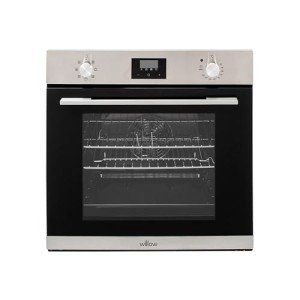The Comprehensive Guide to In-Built Ovens
In-built ovens, likewise known as built-in ovens, are an essential function in contemporary kitchens, combining performance and design in one design. With advancements in technology and a growing emphasis on culinary experiences, in-built ovens have become progressively popular for both amateur cooks and professional chefs. This article provides a comprehensive summary of in-built ovens, their benefits, types, installation, maintenance, and responses to often asked concerns.
What is an In-Built Oven?
A built-in oven is a kitchen device that is designed to be integrated into cabinetry or walls, using a seamless appearance. Unlike you can find out more freestanding ovens, built-in ovens are suited designated areas and are frequently coupled with other appliances, such as built-in microwaves or warming drawers, for a cohesive kitchen style.
Benefits of In-Built Ovens
Built-in ovens provide several advantages over standard ovens. A few of the key benefits consist of:
- Space Efficiency: Built-in ovens conserve important floor area and can assist develop an organized kitchen layout, specifically in smaller areas.
- Visual Appeal: Their sleek design boosts the total look of a kitchen, adding to a modern and structured look.
- Ergonomics: These ovens are often set up at eye level, making it much easier to inspect on food and reduce the risk of flexing down.
- Customization: In-built ovens can be picked based upon particular kitchen styles and personalization choices, allowing house owners to develop their ideal cooking environment.
- Advanced Features: Many built-in ovens come equipped with modern functions like wise control systems, self-cleaning options, and numerous cooking modes, enhancing performance and cooking outcomes.
Types of In-Built Ovens
Built-in ovens are readily available in various types, each dealing with different cooking designs and needs. The main types consist of:
- Single Ovens: A conventional design with one cooking compartment.
- Double Ovens: Featuring 2 cavities, permitting synchronised cooking at various temperature levels.
- Wall Ovens: Installed into the wall at eye level for simple access and reduced flexing.
- Steam Ovens: Use steam to prepare food, protecting wetness and nutrients.
- Convection Ovens: Incorporate fans for even heat circulation, minimizing cooking times.
- Microwave Ovens: A mix of microwave and conventional oven performances, best for versatile cooking requirements.
- Mix Ovens: Combine different cooking methods such as microwave, convection, and standard baking.
Setup of In-Built Ovens
The installation process for inbuilt ovens differs based upon the type and style. Here are some basic steps involved:
- Preparation: Prior to setup, make sure the space is measured correctly and matches the oven's measurements.
- Electrical and Plumbing: If your oven requires a gas line or particular electrical circuits, make certain the required modifications are made beforehand.
- Fitting: Place the oven into the cabinet or wall space and protect it according to maker guidelines, ensuring it is level.
- Ending up Touches: Install any trim or cabinets needed to cover spaces and accomplish a sleek appearance.
Keep in mind: It's typically advised to work with a professional installer, particularly when dealing with electrical or gas connections.
Upkeep of In-Built Ovens
Correct upkeep is essential for making sure the longevity and efficiency of built-in ovens. Here are some essential maintenance tips:
- Regular Cleaning: Wipe down surfaces after each usage, and utilize a self-cleaning function if readily available to minimize buildup.
- Examine Seals: Inspect the door seals routinely to ensure they are intact and tidy.
- Ventilation: Ensure that the oven has correct ventilation, particularly for wall ovens positioned inside kitchen cabinetry.
- Service Checks: Schedule routine service consult qualified technicians to make sure all components are functioning properly.
Frequently Asked Questions About In-Built Ovens
Q1: Are built-in ovens energy effective?A1: Yes, numerous in-built ovens are created to be energy effective, typically including insulation and advanced heating innovations that reduce energy usage.
Q2: Can I install a built-in oven myself?A2: While some house owners might select to install their ovens separately, it is recommended to work with an expert, specifically if electrical or gas connections are included.
Q3: Are inbuilt ovens more expensive than freestanding ovens?A3: In-built ovens usually come at a greater cost point due to their design, customization options, and advanced features.
Q4: How do I pick the right in-built oven for my kitchen?A4: Consider elements such as your cooking routines, the offered area, wanted functions, and your kitchen's style when picking an in-built oven.
In-built ovens are a valuable addition to modern-day cooking areas, blending design and functionality. With various types available, homeowners can choose an oven that best fits their cooking needs and kitchen design. Understanding the setup procedure, maintenance requirements, and functions can improve the cooking experience while including worth to the home. Whether you're an aspiring chef or a casual cook, investing in an inbuilt oven can essentially change the method you prepare meals, bringing both performance and sophistication to your cooking undertakings.
Summary Table of In-Built Oven Types
| Kind of Oven | Key Features |
|---|---|
| Single Oven | One cooking compartment; ideal for standard use. |
| Double Oven | 2 compartments; enables cooking at various temps. |
| Wall Oven | Set up at eye level; reduces flexing. |
| Steam Oven | Cooks with steam; retains nutrients. |
| Convection Oven | Even heat distribution; much faster cooking times. |
| Microwave Oven | Integrates microwave and baking functionalities. |
| Combination Oven | Multiple cooking approaches; versatile cooking alternatives. |
With understanding and factors to consider outlined in this short article, readers can with confidence browse their options for built-in ovens, making notified choices that raise their kitchen experience.

